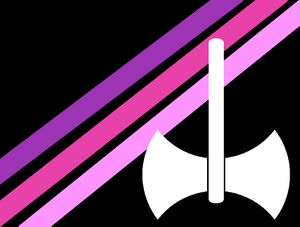Dyke
| |


The words dyke, dike, bulldyke or similar, commonly refer to a lesbian, particularly one with masculine or butch traits (although femmes can also be dykes[1]). The word is commonly considered a derogatory slur, but has been reclaimed and used positively by some lesbians.[2][3] Dyke is sometimes also used as an identity for non-lesbians, such as bisexuals or pansexuals.[1][4]
Dyke is not a label exclusive to binary women.[5] Notable nonbinary or genderqueer people who call themselves dykes include poet Eileen Myles[6], entrepreneur Al Sandimirova[7], and author Rivers Solomon.[8]
Gender Census
In the 2019 Gender Census, 17 people (0.2% percent of respondents) wrote "dyke" as their identity, and one wrote "bulldyke".[9]
In the 2020 Gender Census, 89 respondents identified as a dyke, with an additional six people identifying as "dyke (in relation to gender)"/"dykegender"/"dyke-gender"/"dyke is my gender tbh", and several more as variants such as "dykeish", "dykefag", "boi dyke", "non-binary dyke", etc.[10]
Etymology
The etymology of "dyke" is uncertain. Some hypotheses for its origin include:
- A shortening of hermaphrodite.[11][12]
- Boudicca (Bou-dyke-ah), a Celtic queen who organized a revolt against the Roman Empire in 67 AD.[11]
- From the slang term "get diked out" meaning "dress up".[11]
- In the 19th century, "dike" was a slang term for the vulva.[12]
- From the terms "bulldicker"/"bulldick", meaning "fake penis" or "fake man", describing the idea of "a woman with a clitoris extended enough to serve as a penis in lesbian relationships".[3]
Dyke Marches
A "Dyke March" is a visibility and protest march, much like a Pride parade. The concept began in the early 1980s, with a "Dykes in the Streets" march taking place in Toronto, Ontario in October 1981. It was organized by the now-defunct organization Lesbians Against the Right, and drew 350 participants.[13][14]
The first Dyke March named as such took place in Washington, DC, USA, on April 24, 1993, during the March on Washington for Lesbian, Gay and Bi Equal Rights and Liberation.[15] It was organized by the Lesbian Avengers, and had over 20,000 marchers.[16][17]
Nowadays, Dyke Marches take place during Pride Month in many cities across Canada, the USA, and Europe.
Flag
A dyke pride flag was created in February 2020 by a tumblr user named Jinx/Dizzy (urls frostwitch, agenderwitch, and plantbutch). The black background stands for the "power, strength, and freedom that comes with reclaiming dyke", as well as representing "any and all black wlw and black nonbinary sapphics who identify as dyke, as they have always been the backbone of this community." The purple stripe stands for reclaiming "dyke" from a violent slur into a positive identity label. The magenta stripe stands for unapologetic love of women. The pink stripe stands for acceptance of trans women, as well as inner peace. The white labrys axe represents "empowerment, justice, and intolerance of bigotry".[18]
References
- ↑ 1.0 1.1 @bigbadbutchh (19 August 2020). "like fr look at this dyke march". Archived from the original on 19 August 2020 – via Twitter.
- ↑ https://en.wiktionary.org/wiki/dyke
- ↑ 3.0 3.1 Krantz, Susan E. (1995). "Reconsidering the Etymology of Bulldike". American Speech: A Quarterly of Linguistic Usage.
- ↑ "About Us". DC Dyke March. Retrieved 5 March 2021.
Dyke March is an inclusive community consisting of, but not limited to, black dykes, brown dykes, Latinx, Trans, Two-Spirit, Pan, Bi, Poly, Non-Binary, Disabled, Sex worker, fat, poor, young and old dykes.
- ↑ The San Francisco Dyke March (25 June 2018). "To our community, we want to reiterate our support of ALL dyke identities including transdyke, MTF, transfeminine, transmasculine, genderqueer, and gender fluid dykes". Facebook.
- ↑ @EileenMyles (February 24, 2016). "@DeJesusSaves @rugamarspr plus as a gender queer dyke I am trans" – via Twitter.
- ↑ "The Costs of Identity: Running a business as an LGBTQ+ person". Chasing the Dream. 10 February 2020. Retrieved 3 October 2020.
- ↑ Rivers Solomon bio
- ↑ Cassian (30 March 2019). "Gender Census 2019 - the public spreadsheet".
- ↑ GC2020 Public Copy, 1 November 2020
- ↑ 11.0 11.1 11.2 Belge, Kathy (14 July 2017). "What is the origin of the word "Dyke"?". LiveAbout. Retrieved 15 October 2020.
- ↑ 12.0 12.1 "dyke (n.)". Online Etymology Dictionary. Retrieved 15 October 2020.
- ↑ "Lesbians Battle the Right". The Body Politic. Pink Triangle Press. October 1981. p. 10.
- ↑ Marushka, Anna (November 1981). "Dykes Against the Right". The Body Politic. Pink Triangle Press. p. 13.
- ↑ Cogswell, Kelly (May 18, 2012). "The Dyke March Hits 20!". The Huffington Post. Retrieved 7 November 2020. CS1 maint: discouraged parameter (link)
- ↑ Teeman, Tim (March 22, 2014). "Tick-Tock: The Explosive Power of the Lesbian Avengers". The Daily Beast. Retrieved 3 December 2018. CS1 maint: discouraged parameter (link)
- ↑ "Herstory — NYC Dyke March". New York City Dyke March. 2018. Retrieved 3 December 2018. CS1 maint: discouraged parameter (link)
- ↑ "DYKE FLAG 🪓 👊". 21 February 2020.
| This article uses material from the Wikipedia article Dyke March, which is released under the Creative Commons Attribution-ShareAlike 3.0 Unported License (view authors). |


